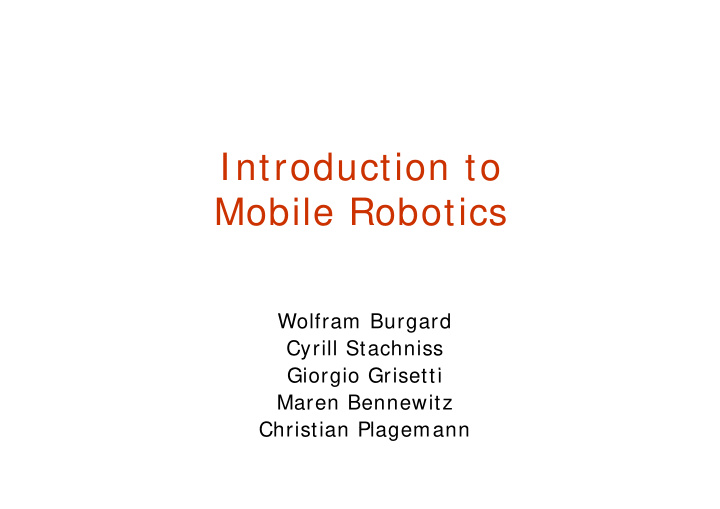



Introduction to Mobile Robotics Wolfram Burgard Cyrill Stachniss Gi Giorgio Grisetti i G i tti Maren Bennewitz Christian Plagemann Christian Plagemann
Organization Organization • We 14: 00 – 16: 00 We 14: 00 16: 00 Fr 11: 00 – 12: 00 • • lectures, discussions lectures discussions • homework, practical exercises • Web page: b • www.informatik.uni-freiburg.de/ ~ ais g /
Goal of this course Goal of this course • Provide an overview of problems / approaches in mobile robotics approaches in mobile robotics • P Probabilistic reasoning: Dealing with b bili ti i D li ith noisy data • Hands-on experience p
AI View on Mobile Robotics AI View on Mobile Robotics Sensor data Sensor data Control system World model Actions
Robotics Yesterday Robotics Yesterday
Current Trends in Robotics Current Trends in Robotics Robots are moving away from factory Robots are moving away from factory floors to • Ente tainment to s Entertainment, toys • Personal services • Medical, surgery • Industrial automation Industrial automation (mining, harvesting, … ) • • Hazardous environments Hazardous environments (space, underwater)
Robotics Today
RoboCup-9 9 , Stockholm , Sw eden , , p
Mobile Manipulation Mobile Manipulation [ Brock et al Robotics Lab Stanford University 2002] [ Brock et al., Robotics Lab, Stanford University, 2002]
Mobile Manipulation Mobile Manipulation
Mobile Manipulation Mobile Manipulation [ Brock et al Robotics Lab Stanford University 2002] [ Brock et al., Robotics Lab, Stanford University, 2002]
d P2 ‘97 Honda P2 ‘97 H Hum anoids: P2
Em otional Robots: Cog & Kism et g [ B ook et l MIT AI L b 1993 tod [ Brooks et al., MIT AI Lab, 1993-today] ]
General Background General Background • Autonomous, automaton Autonomous, automaton • self-willed (Greek, auto+ matos) • Robot • Karel Capek in 1923 play R.U.R. (Rossum’s Universal Robots) ( ) • labor (Czech or Polish, robota) • workman (Czech or Polish, robotnik) ( , )
Asim ov’s Three Law s of Robotics Asim ov s Three Law s of Robotics 1. A robot may not injure a human being, y j g, or, through inaction, allow a human being to come to harm. 2. A robot must obey the orders given it by human beings except when such orders h b i t h h d would conflict with the first law. 3. A robot must protect its own existence as long as such protection does not conflict long as such protection does not conflict with the first or second law. [ Runaround 1942] [ Runaround, 1942]
W iener, Cybernetics W iener, Cybernetics • Studied regulatory systems and their g y y application to control (antiaircraft gun) • “it has long been clear to me that the modern ultra-rapid computing machine was in principle an ideal central nervous system to an apparatus for ideal central nervous system to an apparatus for automatic control; and its input and output need not be in the form of numbers or diagrams, but g , might very well be, respectively, the readings of artificial sensors such as photoelectric cells or thermometers and the performance of motors or thermometers, and the performance of motors or solenoids”. [ Electronics 1949] [ Electronics, 1949]
Trends in Robotics Research Trends in Robotics Research Classical Robotics (mid-70’s) • exact models exact models • no sensing necessary Reactive Paradigm (mid-80’s) Reactive Paradigm (mid 80 s) • no models • relies heavily on good sensing Hybrids (since 90’s) • model-based at higher levels g • reactive at lower levels Probabilistic Robotics (since mid-90’s) • seamless integration of models and sensing • inaccurate models, inaccurate sensors inaccurate models, inaccurate sensors
Brief Case Study: M Museum Tour-Guide Robots T G id R b Minerva, 1998 Rhino, 1997
Rhino Rhino ( Univ. Bonn + CMU, 1 9 9 7 ) ( Univ. Bonn + CMU, 1 9 9 7 )
Minerva Minerva ( CMU + Univ. Bonn, 1 9 9 8 ) ( CMU + Univ. Bonn, 1 9 9 8 ) Minerva Minerva
Architecture of the Control System Architecture of the Control System
Recommend
More recommend